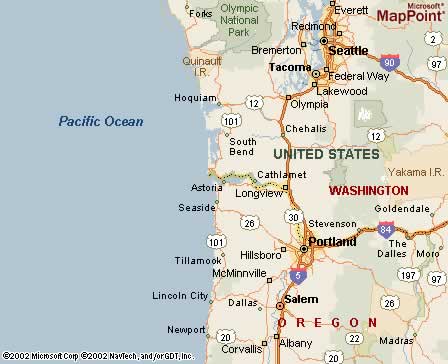|
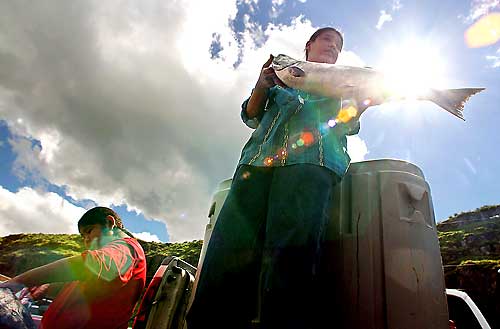 ABOARD
THE MISS ROXANNE — Bright as polished chrome, this monster chinook
pulled thrashing from the lower Columbia River fixes its black eye on
me as I draw close. Fascinated by its silver sheen, its huge size —
it's nearly as long as my leg — and the untold, unimaginable story
of its journey to the deep Pacific and back, I trace my index finger along
the slippery slope of its nose. ABOARD
THE MISS ROXANNE — Bright as polished chrome, this monster chinook
pulled thrashing from the lower Columbia River fixes its black eye on
me as I draw close. Fascinated by its silver sheen, its huge size —
it's nearly as long as my leg — and the untold, unimaginable story
of its journey to the deep Pacific and back, I trace my index finger along
the slippery slope of its nose.
And then it bites me. Hard.
I yelp and yank back my finger,
oozing bright drops of blood.
This mighty spring chinook, still
watching me, has delivered its primal message: Chinook are the king of
all salmon and nobody's pet.
The biggest and strongest of the
five salmon species in Northwest rivers, Columbia River spring chinook
come into the river when it is full and cold. Some barrel on to remote
reaches of Idaho, an inland river journey of 700 miles or so that reaches
the high valleys of the Sawtooth Mountains.
Anchors of the ecosystem, chinook,
even in death, bring vital nutrients upstream from the ocean to inland
forests, nourishing wildlife and habitat. And while their numbers are
greatly diminished from historic abundance, when as many as 16 million
steelhead and salmon thronged the Columbia, some of this year's chinook
runs will be huge — numbers not seen since the 1950s.
Their flesh, oilier than any other
salmon to fuel their journey, sets Columbia River spring chinook apart
— a fact long appreciated by the Columbia River tribes.
Each spring at Celilo Indian Village
near The Dalles, hundreds of Indians from around the Northwest gather
to feast on chinook roasted on alder-wood fires, eaten sitting on tule
mats spread on the earthen floor of the longhouse. This First Salmon ceremony
has since time immemorial celebrated the return of the tribes' most sacred
food.
Tribal elders remember when the
falls at Celilo, one of the greatest salmon fisheries the world has ever
known, roared loud as thunder, the echo bouncing off basalt cliffs, the
spray wetting and cooling their faces as fishermen pulled two and three
leaping fish with each dip of their net.
While the falls are long gone,
drowned by the reservoir backed up by The Dalles Dam in 1957, the reverence
for spring chinook abides.
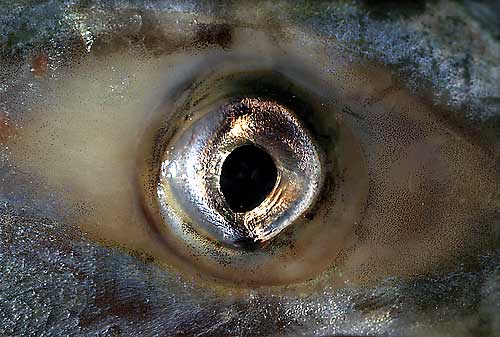 "It
is a food from our Creator, and it sustains us," said Melinda Jim,
54, a Warm Springs tribal member who cans 17 dozen jars of salmon every
year and eats salmon almost daily. "We wouldn't be here without it,"
she said. "It
is a food from our Creator, and it sustains us," said Melinda Jim,
54, a Warm Springs tribal member who cans 17 dozen jars of salmon every
year and eats salmon almost daily. "We wouldn't be here without it,"
she said.
"In our religious ways, it
was the first food that named itself for our benefit when the Creator
called to all of nature to come forward for our food," said Thomas
Morning Owl, master of ceremonies for the powwow at the Celilo a week
ago Sunday. "We honor salmon for that, until the end of time. Eating
it is almost like communion."
For Rodney Risley, 73, of Kelso,
owner of the Miss Roxanne, there also is no other fish that compares.
"They are so fat, they are so good ... they are just a beautiful
fish," Risley says, his weathered face softening. "The prettiest
fish there is."
The scales of a spring chinook
seem to make their own light: They refract color in their silver shine
— lavender, pink, green, gold and more.
The scales, cupped like a contact
lens, are made of calcium and cover every inch of the fish but the head
and fins. Flexible and strong, each scale has rings in it that scientists
can read like the rings of a tree, counting the age of the fish and the
years spent at sea.
TOM REESE / THE SEATTLE TIMES
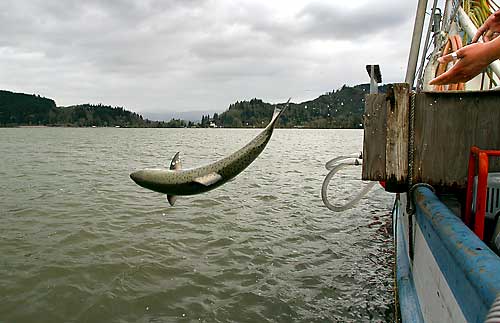 Their
scales, which overlap like shingles on a roof, become larger and harder
as the fish matures. The scales are clear, and bend and flex with the
fish as it moves. Rub your hand down the fish toward the tail and it is
slippery-smooth; go the other way and it is rough as a cat's tongue. Their
scales, which overlap like shingles on a roof, become larger and harder
as the fish matures. The scales are clear, and bend and flex with the
fish as it moves. Rub your hand down the fish toward the tail and it is
slippery-smooth; go the other way and it is rough as a cat's tongue.
All salmon are also covered with
a slick layer of slime that helps them glide through the water and protects
them from bacterial infection. The telltale "fishy" smell comes
from the slime, which is secreted from gland cells scattered across the
surface of the salmon.
Some fish are extravagantly endowed
with such cells: A footlong hagfish can secrete a pail full of slime,
says Charmane Ashbrook, a biologist with the Washington Department of
Fish and Wildlife (WDFW).
The chinook's color comes from
pigment in the skin; the color changes by hormonal cues as the fish enters
its spawning phase. Some salmon species change form dramatically: Sockeye
become crimson red; and all salmon develop bigger teeth to spar for mates,
especially male chum, which grow canine-like fangs long enough to bite
through a boot.
All five species of salmon —
chinook, chum, coho, pink and sockeye — are carnivores, eating herring
and other fish, including their own kind.
Male salmon sometimes also use
those sharp teeth to grab onto their mate as they spawn, said Bruce Sanford,
a chinook expert at the WDFW.
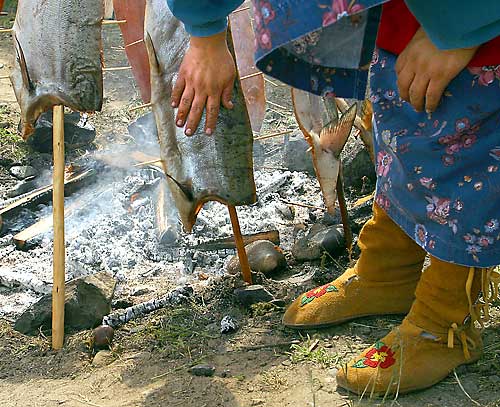 The
female will dig the nest, or redd, with her powerful tail and together
with her mate they release milt and eggs. The eggs lay amid the gravel
and cobble, where fresh, cold, oxygenated water keeps them alive until
their spring hatch. The
female will dig the nest, or redd, with her powerful tail and together
with her mate they release milt and eggs. The eggs lay amid the gravel
and cobble, where fresh, cold, oxygenated water keeps them alive until
their spring hatch.
Historically, salmon migrated 1,200
miles up the main stem of the Columbia River to Lake Windermere in British
Columbia; 900 miles east up the Snake River; and up to 900 miles south
into the Nevada headwaters of the Owyhee River, epic journeys now truncated
by dams. Some chinook must cross nine dams to reach their home waters.
In 1995, spring chinook returns
on the Columbia hit a record low of 10,000 adult fish, including both
wild and hatchery fish. Improved ocean conditions with abundant food supplies
have boosted returns of hatchery fish, but wild runs remain depressed.
Like Puget Sound chinook, most
runs of chinook in the Columbia River are listed for protection under
the federal Endangered Species Act.
More than $1 billion has been spent
to bring the runs back in the Columbia River Basin. These salmon are studied,
counted, fought over and managed; tagged with microchips, radio tags and
liquid-nitrogen brands; electronically scanned like groceries as they
cross the dams; shunted through jungle-gym bypass systems that whoosh
them past turbines, and some will even be hauled to sea in barges, tankers
and pickups.
For all that, much about the salmon
remains a mystery; even how they make it all the way back home isn't completely
understood.
Scientists know salmon rely on
a combination of smell, visual cues, and even the earth's geomagnetism,
star positions and water temperature to get home. But how the fish put
the puzzle together so reliably is not yet known.
Spring chinook migrate upstream
on spring freshets as the snow melts. They are estimated to travel as
much as 30 to 40 miles a day, and can sprint six to eight feet a second.
Strong, resilient, quick with their
teeth and powerful, they are one tough fish. Despite sea lions, seals,
dams, development and gantlets of nets, the chinook keep coming back.
Already, they are streaming into
the Columbia by the thousands — sleek and fat, a silver-bright feast
from the sea.
Lynda V. Mapes: 206-464-2736 or
lmapes@seattletimes.com
|


![]()
 ABOARD
THE MISS ROXANNE — Bright as polished chrome, this monster chinook
pulled thrashing from the lower Columbia River fixes its black eye on
me as I draw close. Fascinated by its silver sheen, its huge size —
it's nearly as long as my leg — and the untold, unimaginable story
of its journey to the deep Pacific and back, I trace my index finger along
the slippery slope of its nose.
ABOARD
THE MISS ROXANNE — Bright as polished chrome, this monster chinook
pulled thrashing from the lower Columbia River fixes its black eye on
me as I draw close. Fascinated by its silver sheen, its huge size —
it's nearly as long as my leg — and the untold, unimaginable story
of its journey to the deep Pacific and back, I trace my index finger along
the slippery slope of its nose.  "It
is a food from our Creator, and it sustains us," said Melinda Jim,
54, a Warm Springs tribal member who cans 17 dozen jars of salmon every
year and eats salmon almost daily. "We wouldn't be here without it,"
she said.
"It
is a food from our Creator, and it sustains us," said Melinda Jim,
54, a Warm Springs tribal member who cans 17 dozen jars of salmon every
year and eats salmon almost daily. "We wouldn't be here without it,"
she said.  Their
scales, which overlap like shingles on a roof, become larger and harder
as the fish matures. The scales are clear, and bend and flex with the
fish as it moves. Rub your hand down the fish toward the tail and it is
slippery-smooth; go the other way and it is rough as a cat's tongue.
Their
scales, which overlap like shingles on a roof, become larger and harder
as the fish matures. The scales are clear, and bend and flex with the
fish as it moves. Rub your hand down the fish toward the tail and it is
slippery-smooth; go the other way and it is rough as a cat's tongue.  The
female will dig the nest, or redd, with her powerful tail and together
with her mate they release milt and eggs. The eggs lay amid the gravel
and cobble, where fresh, cold, oxygenated water keeps them alive until
their spring hatch.
The
female will dig the nest, or redd, with her powerful tail and together
with her mate they release milt and eggs. The eggs lay amid the gravel
and cobble, where fresh, cold, oxygenated water keeps them alive until
their spring hatch. 